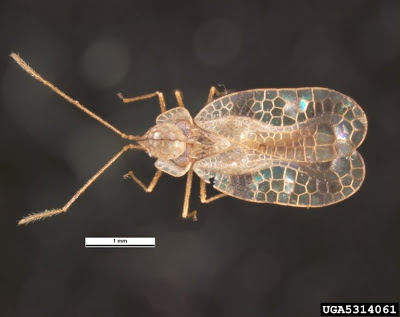Azalea Lace Bug
go.ncsu.edu/readext?619447
en Español / em Português
El inglés es el idioma de control de esta página. En la medida en que haya algún conflicto entre la traducción al inglés y la traducción, el inglés prevalece.
Al hacer clic en el enlace de traducción se activa un servicio de traducción gratuito para convertir la página al español. Al igual que con cualquier traducción por Internet, la conversión no es sensible al contexto y puede que no traduzca el texto en su significado original. NC State Extension no garantiza la exactitud del texto traducido. Por favor, tenga en cuenta que algunas aplicaciones y/o servicios pueden no funcionar como se espera cuando se traducen.
Português
Inglês é o idioma de controle desta página. Na medida que haja algum conflito entre o texto original em Inglês e a tradução, o Inglês prevalece.
Ao clicar no link de tradução, um serviço gratuito de tradução será ativado para converter a página para o Português. Como em qualquer tradução pela internet, a conversão não é sensivel ao contexto e pode não ocorrer a tradução para o significado orginal. O serviço de Extensão da Carolina do Norte (NC State Extension) não garante a exatidão do texto traduzido. Por favor, observe que algumas funções ou serviços podem não funcionar como esperado após a tradução.
English
English is the controlling language of this page. To the extent there is any conflict between the English text and the translation, English controls.
Clicking on the translation link activates a free translation service to convert the page to Spanish. As with any Internet translation, the conversion is not context-sensitive and may not translate the text to its original meaning. NC State Extension does not guarantee the accuracy of the translated text. Please note that some applications and/or services may not function as expected when translated.
Collapse ▲One of the most damaging pests to the Rhododendron species, Azalea Lace Bug can infest large or small plantings of this garden favorite, ravaging the leaves. Unfortunately, infestations often are not noticed until the foliage is badly damaged, usually after the numbers of insects have dwindled to where spraying won’t do much good. Lace bug injury usually becomes most noticeable in August as a bleached or stippling of the upper leaf surface. This leaf injury can give an azalea a grayish-green look and reduce the strength of the plant.
The first step to managing this pest is to examine the underside of the leaves of your azalea and rhododendron plants beginning as early as March. You should continue to monitor the plants weekly through spring and summer. A sure indicator that lace bugs have infested the plants is a rusty-brown color on the undersides of the leaves that looks like soil has splashed onto them, but it is actually the insect’s excrement. Control measures should be applied when the adult insects are first found on the foliage of deciduous plants and when colonies of nymphs are found on evergreens.
Lace bugs lay their eggs in the leaf tissues along the veins of azalea leaves. There are usually two or more generations per year. Hatch dates are relatively dependent on the weather. If the spring is unusually warm then expect an earlier hatch while a cool spring may postpone their emergence. Nymphs when first hatched are almost colorless eventually becoming black and spiny.
The adults are 1/8” long with thin lacy wings dotted with brown and black markings. The nymphs and adults cause their damage by sucking the sap from the underside of the leaves of the azalea. This feeding results in the gray splotched appearance on the upper leaves. Later in the season as the tissue around the tiny wounds die the damage manifests itself to the dismay of the gardener.
Join the Extension Master Gardener℠ volunteers of Union County for Ask a Master Gardener from 9–11 a.m. this Saturday, August 31, 2019, at their Teaching Garden at the Union County Agriculture Center.





